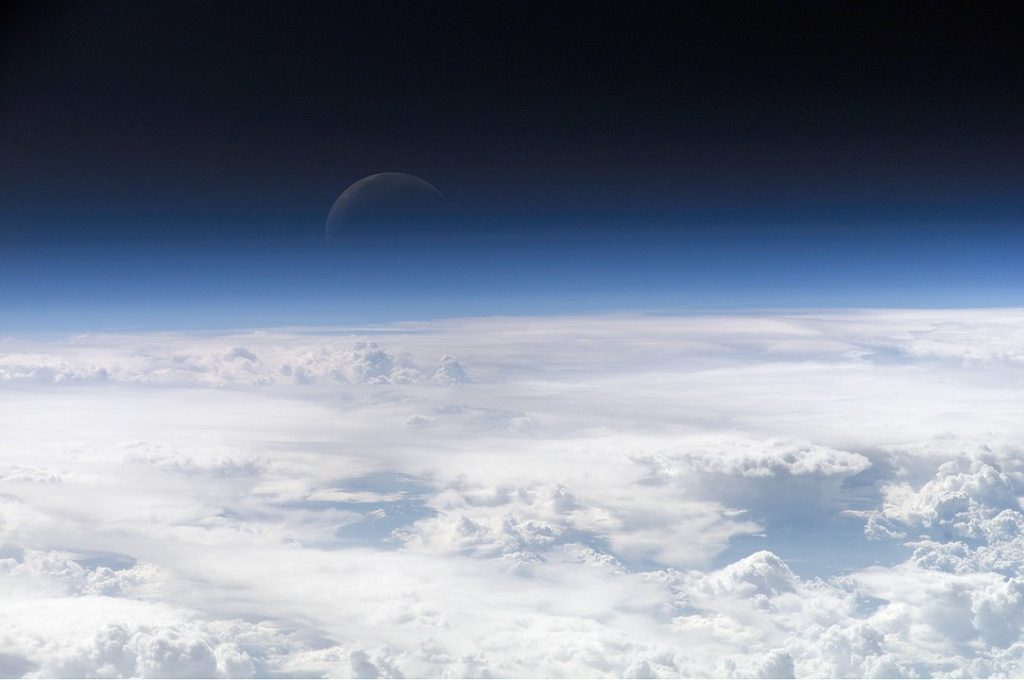
Where does space start? Technically, it starts at 100 km, but there are five different definitions.
Space begins at the Kármán Line, which is 100 kilometers above sea level. There is obviously no sign that says, “Welcome to Space!”, so any line that shows the boundary of space has to be arbitrary. The reasoning behind the Kármán Line was thought up by Theodore von Kármán. He was a Hungarian mathematician and aerospace engineer who worked heavily in the field of aerodynamic theory. He came up with the line idea in 1957. As a vehicle ascends above the Earth, the atmosphere gets thinner and thinner. At the Kármán Line, the atmosphere is too thin to provide enough lift for a conventional plane to fly. A rocket can fly because it only relies on the thrust of its engine. A plane needs the lift of the air to fly, and there is not enough air at this height. In order to keep flying at this height, a plane would need to reach orbital velocity to keep flying. If it can’t attain this speed, it would fall back to Earth. Interestingly, the highest a plane has ever flown is 37,650 m. Aleksandr Fedotov of the USSR flew a modified MIG-25 on August 3rd, 1977 and reached this height. A few planes have flown higher, but they were all launched from other planes and don’t count. The American X-15 reached 95,916 meters.
The Kármán Line is an easy number to remember and it serves its purpose, however, there are other definitions of where space begins. It doesn’t seem that a different definition would be necessary, but it turns out it matters militarily. Outer space is international territory, which means that no country can own it. This appears to upset the United States. In the same way as every country owns the sea around their borders to a distance of 19.3 km and they can exploit the sea to a distance of 321.8 km, all countries own the air above them. If the Kármán Line is accepted as the limit of the airspace, that means anything above 100 km is international territory. Since, 1958, there have been many treaties signed to ensure that “outer space” is international territory, but the United States has been adamant that every time a country talks about the edge of space, they have to add that space begins at “around” 100 km and that this is not an official definition. The reason for this is that the United States wants to make sure it can control the airspace above it as technology advances to allow it. They don’t want to be “boxed in” by an official definition.
So, where does space start? What are the different boundaries of space? There are five that I could find.
80 km is the lowest. This is the point where aerodynamic control surfaces don’t work anymore. This is used by the National Advisory Committee on Aeronautics. This limit was worked out using the North American X-15, a hypersonic rocket-powered aircraft. The X-15 had two flight systems, one for in the atmosphere and one for outer space. The onboard computer was programmed to switch from atmospheric flight to outer space flight when the atmosphere became too thin and 80 km was the point where this happened. The atmosphere became too thin for the wings to give any lift and the plane had to switch to purely thrust.
100 km is the Kármán Line. This is used by the Fédération Aéronautique Internationale, the International Air Sports Federation, and the US Aeronautic Association. 118 km is the next boundary. This is a theoretical point, but it isn’t used by any organization. This is the midpoint between the gentle winds of the Earth’s atmosphere and the violent winds of charged particles in space.
122 km is the boundary recognized by NASA. This is the point in reentry where atmospheric drag becomes noticeable. This is also the point where the spaceshuttle changes from astronautical control using thrusters to aeronautical control using air surfaces.
129 to 150 km is used by the US Army, according to a training text. 150 km is the lowest point a satellite can orbit the Earth, although this is too low to orbit more than once. It is a pretty arbitrary height.
As more countries and private companies increase their spending on satellites and space flight, it might be necessary to come up with an official boundary to space. It would be nice if all countries came together with the goal of exploring space and forgot about all of their differences. However, as long as several countries are opposed to this, it seems unlikely that it will happen.
So, space technically starts at 100 km, but there are multiple definitions. And this is what I learned today.
Sources
https://www.spacefoundation.org/space_brief/international-space-law/
https://commons.erau.edu/cgi/viewcontent.cgi?article=1052&context=stm
https://en.wikipedia.org/wiki/K%C3%A1rm%C3%A1n_line
https://en.wikipedia.org/wiki/Outer_space
https://www.nesdis.noaa.gov/news/where-space
https://commons.erau.edu/cgi/viewcontent.cgi?article=1052&context=stm
